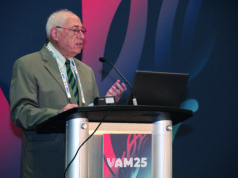
Preoperative diagnosis of lesion-specific ischemia using coronary computed tomography (CT)-derived fractional flow reserve (FFRCT) and ischemia-targeted coronary revascularization after carotid endarterectomy (CEA) can reduce the five-year risk of cardiac death and myocardial infarction (MI) by more than 50% and improve long-term-survival, new data show.
The findings, from a single-center observational study, represent the latest results from Dainis Krievins, MD, and colleagues from Pauls Stradins Clinical University Hospital in Riga, Latvia, on the use of FFRCT in patients undergoing vascular procedures. The data were presented at the 2025 Southern Association for Vascular Surgery (SAVS) annual meeting in St. Thomas, the U.S. Virgin Islands ( Jan. 22–25).
Fundamentally, Krievins et al sought to determine whether FFRCT-guided coronary revascularization improves long-term survival of CEA patients, under the theory that if coronary CT angiography identifies coronary stenosis, FFRCT more precisely shows functional significance of lesions.
The cohort study included 200 patients with no cardiac history or coronary symptoms undergoing elective CEA from 2017–2019, Krievins outlined. Half received preoperative cardiac evaluation with FFRCT to identify asymptomatic ischemia-producing coronary stenoses with ischemia-targeted coronary revascularization following CEA, compared to matched controls with standard preoperative cardiac evaluation and no elective coronary revascularization. In the FFRCT cohort, lesion-specific ischemia was defined as FFRCT ≤0.80 distal to >30% stenosis, and severe ischemia as FFRCT ≤0.75. Endpoints included all-cause death, cardiac death, MI, stroke and major adverse cardiovascular events (MACE) at five-year follow-up.
Of those patients in the FFRCT cohort, coronary CT revealed ≥50% stenosis in 48 patients, with lesion-specific coronary ischemia present in 57 FFRCT patients, severe ischemia in 44, multivessel ischemia in 28, and left main ischemia in seven patients. Forty-three patients had no coronary ischemia (FFRCT >0.80). The status of coronary ischemia in the control cohort was unknown, Krievins noted.
Elective coronary revascularization was performed one to three months following CEA in 33 patients: 27 patients underwent percutaneous coronary intervention (PCI) and six coronary artery bypass grafting (CABG).
Krievins revealed that, at five years, there was a two-fold reduction in all-cause death in the FFRCT group compared to controls—24% vs. 11%. Annual mortality in the control group was 4.8% compared to 2.3% among the FFRCT cohort. Further, there was a four-fold reduction in risk of cardiac death, seven-fold reduction in the risk of MI, and three-fold reduction in MACE, he added. There was no difference in stroke rate.
A subgroup analysis of patients with significant ischemia who underwent coronary revascularization showed that all-cause mortality was similar to those who had no ischemia, Krievins continued. Further, among those with significant ischemia but who did not undergo coronary revascularization, all-cause mortality was similar to the control group.
Five-year survival was 76% in the control group and 89% among the FFRCT cohort. “Improved survival is associated with diagnosed treatment of asymptomatic ischemic-producing coronary stenosis,” Krievins said, concluding: “Patients with no known coronary artery disease undergoing CEA have a high prevalence of silent, or asymptomatic, coronary ischemia, which is a marker for high risk of death and MIs. This single center study showed that preoperative diagnosis of lesion-specific ischemia using coronary CT-derived FFR together with ischemia-targeted coronary revascularization following CEA can improve five-year risk of cardiac death and MI by more than half and improve long-term survival.”
Validation of the results require multicenter randomized trials, one of which, SCORECAD, is currently underway, Krievins added.












